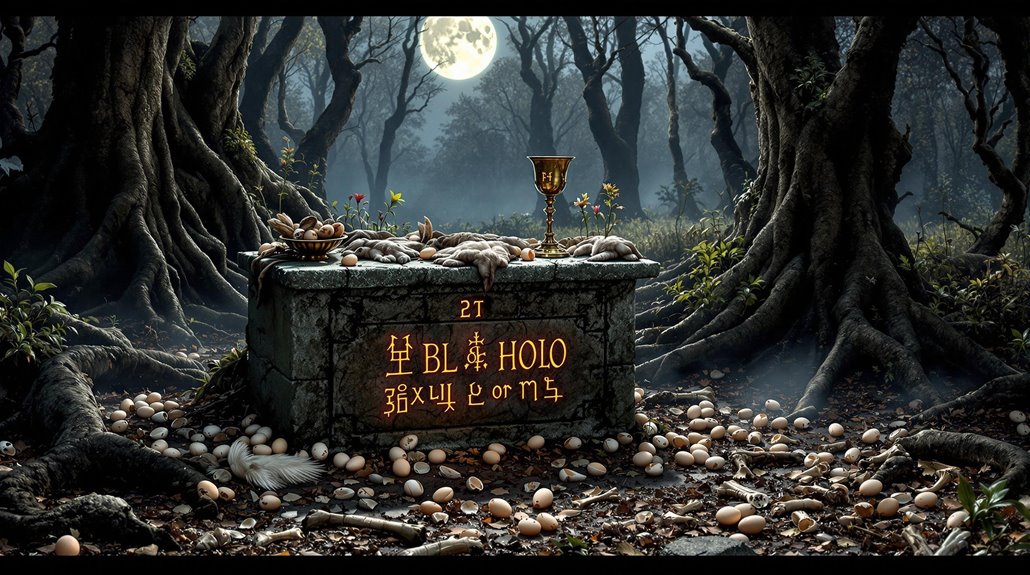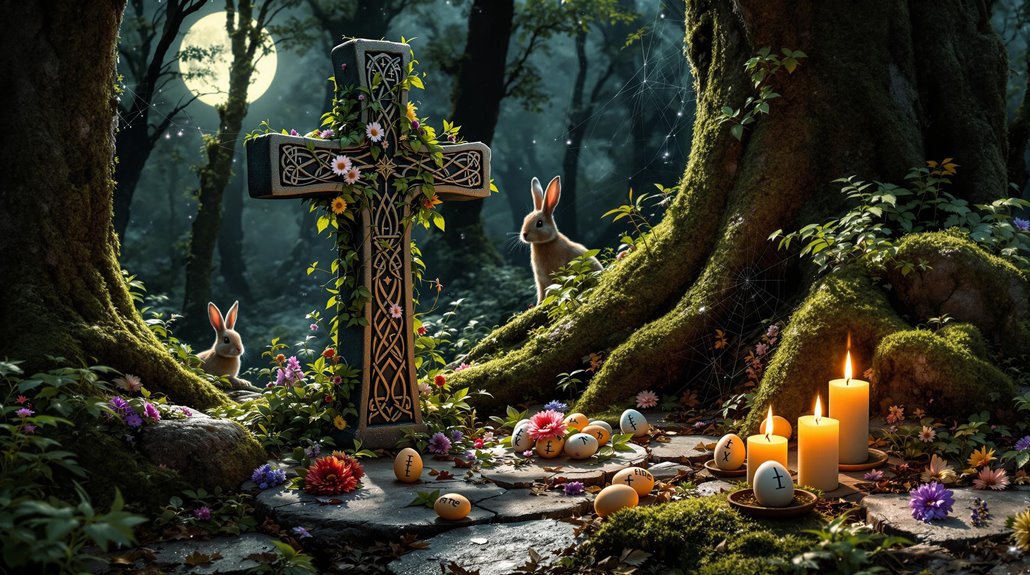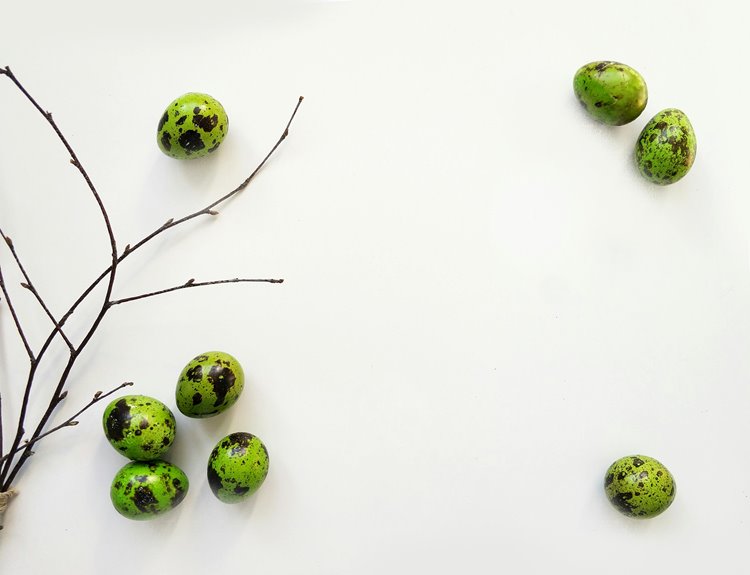You’ve been deceived about Easter’s cheerful origins. The spring celebration traces back to the Germanic goddess Eostre’s blood rituals and fertility cult practices, where ancient pagans performed midnight sacrifices under spring moons. While today’s chocolate bunnies and pastel eggs seem innocent, they’re sanitized versions of fertility symbols and sacrificial offerings. Christianity strategically rebranded these pagan festivals, transforming dark ceremonies into family-friendly celebrations. The truth behind your Easter traditions runs deeper than you imagine.
The Pagan Roots of Easter and Goddess Eostre’s Dark Rituals

Although many associate Easter with cheerful bunnies and pastel eggs, the holiday’s true origins trace back to dark pagan rituals honoring the Germanic goddess Eostre.
You’ll find her influence woven throughout modern celebrations, though merchants have sanitized her story for mass consumption.
Eostre’s rituals centered on fertility symbolism, with worshippers gathering at midnight to perform blood sacrifices and wild dances under the spring moon.
You’re likely unaware that these ancient ceremonies involved rabbits being sacrificed as fertility offerings, while eggs were dyed with natural pigments and human blood.
Archaeological evidence suggests these practices continued well into the 8th century, when Christian missionaries began systematically suppressing pagan traditions.
Yet you’ll still see Eostre’s symbols commercialized today in grocery store aisles and children’s Easter baskets.
Ancient Spring Fertility Cults and Their Influence
Spring fertility cults predated Eostre’s following by several millennia, spreading their influence across ancient civilizations through elaborate agricultural ceremonies.
You’ll find their fertility symbols embedded in modern traditions, from decorated eggs to blooming flowers, all carefully designed to guarantee bountiful harvests.
These seasonal celebrations weren’t simply festive gatherings. Ancient cults performed complex rituals involving human sacrifice, ritualistic orgies, and blood offerings to appease their fertility deities.
Archaeological evidence reveals mass graves near ceremonial sites, where cult leaders disposed of sacrificial victims after spring equinox celebrations. The practices became so widespread that Roman authorities eventually banned several major fertility cults, though their symbols persisted through underground movements.
Today’s cheerful Easter customs mask these darker origins, sanitized over centuries of religious and cultural evolution.
Hidden Symbolism Behind Easter’s Modern Customs
Modern Easter traditions conceal layers of pre-Christian symbolism that today’s celebrants rarely recognize.
You’ll find hidden meanings in seemingly innocent customs, from the eggs you’re dyeing to the bunnies decorating your home. These cultural interpretations reveal a complex merger of pagan fertility rites with Christian doctrine.
Your Easter egg hunt isn’t just child’s play – it’s a commodified version of ancient spring fertility rituals.
The rabbit you’ve embraced as a holiday mascot? It’s a pagan symbol of reproduction, strategically rebranded for mass market appeal.
Even your Easter feast carries echoes of pre-Christian harvest celebrations, though modern marketing has expertly disguised these connections.
The chocolate eggs you’re consuming represent nature’s rebirth, while the traditional ham parallels ancient sacrificial practices.
You’re participating in millennia-old traditions, whether you realize it or not.
How Christianity Transformed Pagan Celebrations

When early Christian leaders encountered widespread pagan festivals, they executed a masterful rebranding strategy. Through careful cultural adaptation, they systematically transformed ancient celebrations into Christian observances, ensuring their faith’s dominance across Europe.
You’ll find these calculated changes reflected in Easter’s evolution:
- The spring equinox festivities honoring fertility goddesses became celebrations of Christ’s resurrection.
- Sacred pagan symbols like eggs and rabbits were infused with Christian symbolism.
- The timing of Easter was deliberately aligned with existing lunar-based festivals to ease conversion.
You’re witnessing the results of this strategic shift today, as modern Easter traditions blend pagan roots with Christian meaning.
What you celebrate now represents centuries of carefully orchestrated religious marketing, designed to make the change from old beliefs to new as seamless as possible.
The Easter Bunny’s Surprising Historical Origins
Despite its cuddly modern image, the Easter Bunny emerged from a ruthless marketing campaign that would rival today’s corporate rebranding specialists.
You’ll find its roots in ancient bunny folklore, where Germanic tribes worshipped Eostre, a fertility goddess whose sacred animal was the hare. This pagan symbol underwent a calculated transformation when 17th-century German Protestants repackaged it as the “Easter Hare” to boost holiday appeal.
You’re being sold a sanitized version of history. The original fertility symbols included hares engaging in frenzied mating rituals, which merchants cleverly softened into the child-friendly rabbit that’s recognized today.
What started as raw paganism morphed into a commercialized mascot, complete with confectionery eggs and pastel merchandise. The Easter Bunny’s evolution represents one of history’s most successful brand transformations.
Conclusion
As you’ve discovered, Easter’s dark origins reveal a $21.6 billion annual commercial enterprise built on ancient pagan rituals. You’re now part of a consumer tradition that’s evolved from blood sacrifice to chocolate bunnies, proving how deeply marketing can reshape cultural memory. While modern celebrations focus on renewal and joy, you can’t ignore the fascinating transformation from Eostre’s primal ceremonies to today’s pastel-colored festivities. The truth beneath the sugar coating remains compelling.





